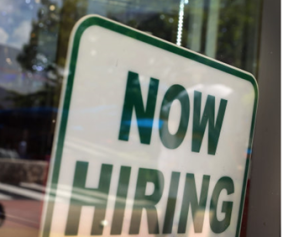US Job Openings Hit 14-Year High in February
Friday, April 10th, 2015 @ 12:49PM
Between the Lines
While last Friday’s unemployment report for March was a huge disappointment with only 126,000 new jobs created last month, the Labor Department had some good news to report on Tuesday. The Bureau of Labor statistics (BLS) reported that the number of job openings in the US hit a 14-year high of 5.13 million in February, up 168,000 from January.
So what does an increase in the number of job openings mean for the economy? First, it means that businesses are feeling more confident about the future. Second, it means more opportunities for the unemployed to find jobs, assuming they have the right skills, and opportunities for already employed workers to advance up the chain.
According to the BLS, over the 12 months ending in February 2015, hires totaled 59.3 million and separations totaled 56.1 million, yielding a net employment gain of 3.2 million. These figures include workers who may have been hired and separated more than once during the year.
The BLS reported on Friday that there are 2.6 million long-term unemployed (those out of work for 27 weeks or longer) in the US. With job openings at 5.13 million, that’s almost two job openings for each of them. And it also means more opportunities for the 6.7 million part-time workers who would rather be working full-time.
Of course, it’s not that simple. The trick that lies ahead is how to match up all of those long-term unemployed people with the job openings. Due to skills, qualification requirements, geography and pay, that is much more difficult than simply saying there are twice as many openings as there are long-term unemployed people.
While the BLS reported that actual hiring in February slowed slightly, the latest increase in job openings suggests that hiring could rebound in the coming months. Businesses have been slow to fill openings for much of the recovery and may start filling more of their open jobs in April.
A total of 4.9 million new hires were made in February, according to the BLS. There were also 4.7 million total job separations, 2.7 million of which were “quits,” meaning that the worker decided to leave rather than being fired or laid off.
Voluntary employment separations (quits) are, generally speaking, a good sign for the US economy. It means workers feel more confident in their ability to find work elsewhere if they aren’t satisfied with their position, salary or working conditions. It suggests they have options.
A survey published earlier this year by Saba Enterprise Software found that 36% of US employees were actively searching for a new job and were looking to leave, on average, within the next seven months. The survey also found that over half (55%) of those looking for a new job have been in their current position for less than five years.
Other recent data point to better hiring and growth in the second quarter. The number of people seeking unemployment benefits fell last week. And a survey of service firms, including retailers, banks and construction companies, found that they expanded at a healthy pace last month.
At the same time, layoffs plummeted 7.6% to 1.6 million, the lowest level in 16 months. Generally speaking, that points to a higher degree of job security for those who are employed.
With the improving job landscape, employers will increasingly have to focus on attracting and retaining talented employees. And who knows, maybe wages will start rising meaningfully in the months ahead.
Gallup Economic Confidence Index Dips in March
Gallup’s US Economic Confidence Index registered its first negative monthly reading of 2015 in March, slipping to -2. This is down from +1 in February and +3 in January. The monthly index emerged from negative territory in January of this year after seven years of scores well below zero.
At a reading of zero, the Index suggests that about half of those surveyed have a positive outlook on the economy, while about half have a negative view. Although the Index dipped slightly in March, it has seen a significant improvement since last year. The dip in March was likely due to the latest round of disappointing economic reports.
Posted by AIA Research & Editorial Staff
Categories: Between the Lines




